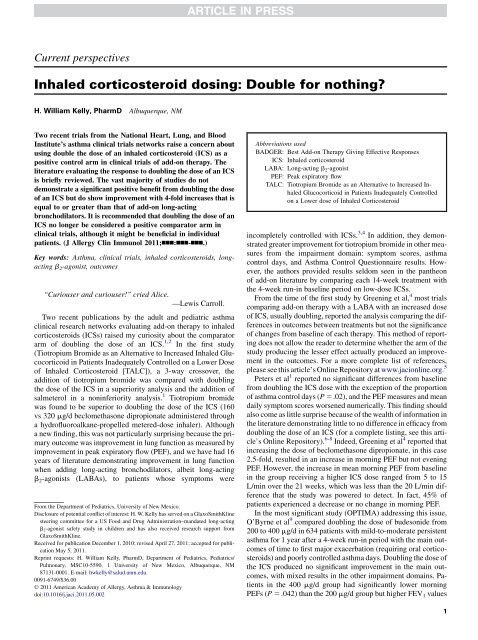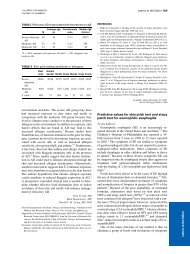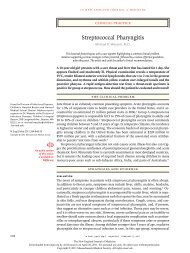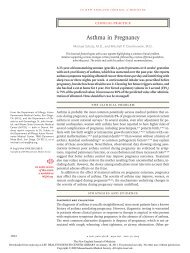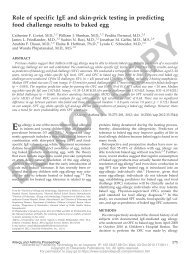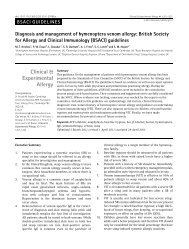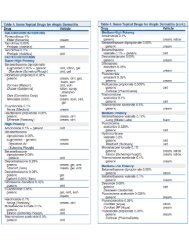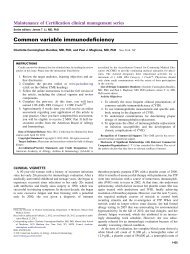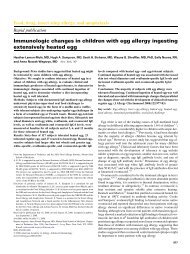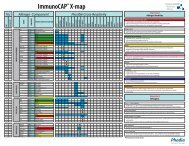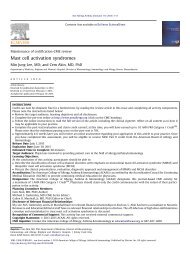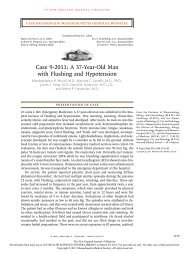Inhaled corticosteroid dosing Double for nothing - JACI 2011 - AInotes
Inhaled corticosteroid dosing Double for nothing - JACI 2011 - AInotes
Inhaled corticosteroid dosing Double for nothing - JACI 2011 - AInotes
Create successful ePaper yourself
Turn your PDF publications into a flip-book with our unique Google optimized e-Paper software.
Current perspectives<strong>Inhaled</strong> <strong>corticosteroid</strong> <strong>dosing</strong>: <strong>Double</strong> <strong>for</strong> <strong>nothing</strong>?H. William Kelly, PharmD Albuquerque, NMTwo recent trials from the National Heart, Lung, and BloodInstitute’s asthma clinical trials networks raise a concern aboutusing double the dose of an inhaled <strong>corticosteroid</strong> (ICS) as apositive control arm in clinical trials of add-on therapy. Theliterature evaluating the response to doubling the dose of an ICSis briefly reviewed. The vast majority of studies do notdemonstrate a significant positive benefit from doubling the doseof an ICS but do show improvement with 4-fold increases that isequal to or greater than that of add-on long-actingbronchodilators. It is recommended that doubling the dose of anICS no longer be considered a positive comparator arm inclinical trials, although it might be beneficial in individualpatients. (J Allergy Clin Immunol <strong>2011</strong>;nnn:nnn-nnn.)Key words: Asthma, clinical trials, inhaled <strong>corticosteroid</strong>s, longactingb 2 -agonist, outcomes‘‘Curiouser and curiouser!’’ cried Alice.—Lewis Carroll.Two recent publications by the adult and pediatric asthmaclinical research networks evaluating add-on therapy to inhaled<strong>corticosteroid</strong>s (ICSs) raised my curiosity about the comparatorarm of doubling the dose of an ICS. 1,2 In the first study(Tiotropium Bromide as an Alternative to Increased <strong>Inhaled</strong> Glucocorticoidin Patients Inadequately Controlled on a Lower Doseof <strong>Inhaled</strong> Corticosteroid [TALC]), a 3-way crossover, theaddition of tiotropium bromide was compared with doublingthe dose of the ICS in a superiority analysis and the addition ofsalmeterol in a noninferiority analysis. 1 Tiotropium bromidewas found to be superior to doubling the dose of the ICS (160vs 320 mg/d beclomethasone dipropionate administered througha hydrofluoroalkane-propelled metered-dose inhaler). Althougha new finding, this was not particularly surprising because the primaryoutcome was improvement in lung function as measured byimprovement in peak expiratory flow (PEF), and we have had 16years of literature demonstrating improvement in lung functionwhen adding long-acting bronchodilators, albeit long-actingb 2 -agonists (LABAs), to patients whose symptoms wereFrom the Department of Pediatrics, University of New Mexico.Disclosure of potential conflict of interest: H. W. Kelly has served on a GlaxoSmithKlinesteering committee <strong>for</strong> a US Food and Drug Administration–mandated long-actingb 2 -agonist safety study in children and has also received research support fromGlaxoSmithKline.Received <strong>for</strong> publication December 1, 2010; revised April 27, <strong>2011</strong>; accepted <strong>for</strong> publicationMay 5, <strong>2011</strong>.Reprint requests: H. William Kelly, PharmD, Department of Pediatrics, Pediatrics/Pulmonary, MSC10-5590, 1 University of New Mexico, Albuquerque, NM87131-0001. E-mail: hwkelly@salud.unm.edu.0091-6749/$36.00Ó <strong>2011</strong> American Academy of Allergy, Asthma & Immunologydoi:10.1016/j.jaci.<strong>2011</strong>.05.002Abbreviations usedBADGER: Best Add-on Therapy Giving Effective ResponsesICS: <strong>Inhaled</strong> <strong>corticosteroid</strong>LABA: Long-acting b 2 -agonistPEF: Peak expiratory flowTALC: Tiotropium Bromide as an Alternative to Increased <strong>Inhaled</strong>Glucocorticoid in Patients Inadequately Controlledon a Lower dose of <strong>Inhaled</strong> Corticosteroidincompletely controlled with ICSs. 3,4 In addition, they demonstratedgreater improvement <strong>for</strong> tiotropium bromide in other measuresfrom the impairment domain: symptom scores, asthmacontrol days, and Asthma Control Questionnaire results. However,the authors provided results seldom seen in the pantheonof add-on literature by comparing each 14-week treatment withthe 4-week run-in baseline period on low-dose ICSs.From the time of the first study by Greening et al, 4 most trialscomparing add-on therapy with a LABA with an increased doseof ICS, usually doubling, reported the analysis comparing the differencesin outcomes between treatments but not the significanceof changes from baseline of each therapy. This method of reportingdoes not allow the reader to determine whether the arm of thestudy producing the lesser effect actually produced an improvementin the outcomes. For a more complete list of references,please see this article’s Online Repository at www.jacionline.org. 5Peters et al 1 reported no significant differences from baselinefrom doubling the ICS dose with the exception of the proportionof asthma control days (P 5.02), and the PEF measures and meandaily symptom scores worsened numerically. This finding shouldalso come as little surprise because of the wealth of in<strong>for</strong>mation inthe literature demonstrating little to no difference in efficacy fromdoubling the dose of an ICS (<strong>for</strong> a complete listing, see this article’sOnline Repository). 6-8 Indeed, Greening et al 4 reported thatincreasing the dose of beclomethasone dipropionate, in this case2.5-fold, resulted in an increase in morning PEF but not eveningPEF. However, the increase in mean morning PEF from baselinein the group receiving a higher ICS dose ranged from 5 to 15L/min over the 21 weeks, which was less than the 20 L/min differencethat the study was powered to detect. In fact, 45% ofpatients experienced a decrease or no change in morning PEF.In the most significant study (OPTIMA) addressing this issue,O’Byrne et al 9 compared doubling the dose of budesonide from200 to 400 mg/d in 634 patients with mild-to-moderate persistentasthma <strong>for</strong> 1 year after a 4-week run-in period with the main outcomesof time to first major exacerbation (requiring oral <strong>corticosteroid</strong>s)and poorly controlled asthma days. Doubling the dose ofthe ICS produced no significant improvement in the main outcomes,with mixed results in the other impairment domains. Patientsin the 400 mg/d group had significantly lower morningPEFs (P 5.042) than the 200 mg/d group but higher FEV 1 values1
2 KELLYJ ALLERGY CLIN IMMUNOLnnn <strong>2011</strong>(P 5 .02). There were no significant differences in nights withawakenings or the number of rescue inhalations, but there was adecrease of 3.1% in days with symptoms (P 5 .017) <strong>for</strong> the 400mg/d group. The small differences were likely statistically significantbecause of the large number of patients in the study. Theevaluation of exacerbations complements the study by addingthe risk domain that many of the studies do not include becauseof insufficient duration and too few patients.In a meta-analysis of studies assessing the effect of higher dosesof ICSs on reducing the risk of exacerbation, only 2 studiesdemonstrated a reduction in exacerbations, and they both used a4-fold increment in <strong>dosing</strong>. 8 In the largest study Pauwels et al 10compared budesonide at 200 and 800 mg/d in 427 patients withmoderate persistent asthma treated <strong>for</strong> 1 year after a 4-week runinperiod. They also included 2 other comparator groups with thesame ICS doses and the addition of the LABA <strong>for</strong>moterol. They reporteda 49% reduction in exacerbations between the low-dose andhigher-dose budesonide (P _5% difference in FEV 1 )and preference statistical analysis to determine the differential responseto the 3 treatments. This analysis allows the clinician to determinenot only which therapy is generally better but whichtherapy is better in a higher proportion of patients. By then assessingpredictors of individual responses or preferences, this movesus closer to being able to individualize therapy. The authors reportedgreater proportions preferring LABA step-up therapy tomontelukast (52% vs 34%, P 5 .02) and ICS step-up therapy(54% vs 32%, P 5 .004) with no difference between the proportionpreferring ICSs and montelukast. On this basis, the accompanyingeditorial suggested that physicians might want to start withthe less-preferred therapies to avoid risks associated with LABAuse. However, the underlying assumption of a preference analysisis that all of the treatment arms have been shown to be effective;otherwise, one should have a placebo arm so that randomly occurringdifferences in preference can be quantified.The Childhood Asthma Research and Education Networkundertook the BADGER study because there were few data tocompare the relative effectiveness of various step-up strategies inchildren. Although there were a number of trials establishing theefficacy of the addition of LABAs to ICSs, 5 there were minimaldata to suggest the effectiveness of doubling the dose of ICS oradd-on montelukast in that age group, particularly <strong>for</strong> the outcomemeasures they used. 11,14-16Shapiro et al 11 reported a significant difference in FEV 1 (meandifference, 4.2%) over 12 weeks between 200 and 800 mg/d budesonidebut not between 400 and 800 mg/d budesonide (mean difference,0.4%) in 404 children 6 to 18 years of age. They observedsimilar findings <strong>for</strong> daytime symptom scores, with the only significantdifference found between 200 and 800 mg/d.Verberne et al 14 compared the addition of salmeterol with doublingthe dose of chlorofluorocarbon-propelled beclomethasonedipropionate from 400 to 800 mg/d in 177 children with moderateasthma over a 1-year period. Unlike many studies, they continuedthe low-dose ICS in 1 arm of the study. They found no differencebetween the low- and high-dose ICS arms <strong>for</strong> improvement in
J ALLERGY CLIN IMMUNOLVOLUME nnn, NUMBER nnKELLY 3FEV 1 , exacerbations, or symptom scores, nor did they find an improvementwith the addition of salmeterol, but they did report decreasedgrowth in the higher-dose ICS arm compared with theother study arms.A more recent study by the same group that was published afterthe BADGER study compared 400 mg/d fluticasone propionatewith 200 mg/d fluticasone propionate plus 100 mg/d salmeterol in158 children aged 6 to 16 years with uncontrolled symptoms on 4weeks of 200 mg/d fluticasone propionate. 15 They reported no differencebetween treatments over 26 weeks and no significant improvementfrom baseline in lung function. However, they diddemonstrate a significant 25% improvement in symptom-freedays with both therapies over baseline.It is possible that the symptom-free days used in OPTIMA orthe asthma control days used in the BADGER and TALC studiesare more sensitive measures of therapeutic effect and differentialand dose response in both children and adults with relativelynormal lung function. Un<strong>for</strong>tunately, the BADGER study did notreport which of the hierarchic outcomes drove the differentialresponse. Simons et al 16 compared the addition of montelukast orplacebo to 400 mg/d budesonide in a crossover trial in 279 children6 to 14 years of age with moderate asthma. They reportedno significant difference in FEV 1 in the intention-to-treat populationbut a significant (P 5 .01) 2% mean difference from placeboin the per-protocol population. There was no difference in exacerbations,and asthma control days were not measured. Thus anotherperspective of the results from the BADGER study wouldbe that the preference rates exhibited by the 2 alternate treatmentsof adding montelukast or doubling the <strong>corticosteroid</strong> dose justrepresent the random preference rate had <strong>nothing</strong> (with only placeboadded) been done.The dose-response data <strong>for</strong> ICSs in infants and young childrenless than 5 year of age are even more tenuous (<strong>for</strong> morein<strong>for</strong>mation, see this article’s Online Repository). A review ofthe pivotal trials <strong>for</strong> budesonide nebulizer suspension found thatonce the dose exceeded 0.25 mg once daily, which was inconsistentlybetter than placebo, there were no significant differences inefficacy from doses of 0.5 to 1.0 mg/d. Similar results have beenreported from studies of chlorofluorocarbon-propelled fluticasonepropionate administered through a valved holding chamber with amask in which 100 mg/d (88 mg/d as labeled by the US Food andDrug Administration) did not produce consistent efficacy overplacebo but 200 mg/d did. No dose-response studies with thenewer hydrofluoroalkane-propelled ICSs have been completedin this population, nor have many efficacy and safety trials beenper<strong>for</strong>med. These are badly needed.Finally, what does this mean <strong>for</strong> the practitioner? Should theynot bother doubling the dose of an ICS if patients’ symptoms areuncontrolled with the current dose? Few studies have been designedto assess the potential <strong>for</strong> individual patient responses.However, 2 studies have looked at this issue.Szefler et al 17 per<strong>for</strong>med a dose-escalation study of beclomethasonedipropionate (n 5 12) and fluticasone propionate (n 59) with FEV 1 and bronchial responsiveness to methacholine asoutcome measures. The first dose escalation was 4-fold and thenext was 2-fold, representing the low, medium, and high dosesfrom the guidelines. There were 1 to 2 patients in each groupwho demonstrated improvement in the end point after the doublingdose.Bateman et al, 18 in the much larger (n 5 3421) Gaining OptimalAsthma Control study, compared the use of escalating dosesof combination ICS/LABA therapy with ICS monotherapy in establishingwell-controlled and completely controlled asthma. Theincreases in the dose of fluticasone propionate were 200, 500, and1000 mg/d. In the 550 patients who entered the study receiving nobaseline ICS therapy and who received monotherapy, 39%achieved well-controlled status, but an additional 18% achievedwell-controlled status with the first doubling of the dose, andthen an additional 5% achieved well-controlled status with thesecond doubling dose. Similar findings were reported <strong>for</strong> the doublingof doses in the 577 patients who entered the study receivinglow-dose ICSs.Thus it is clearly possible to improve asthma control inindividual patients with mild-to-moderate asthma by doublingthe dose of ICS from low to medium and from medium to high.The problem as an arm in comparative clinical trials is that thelargest proportion of patients achieve well-controlled status atlow doses of ICSs, and in those who do not, only an additional15% to 20% will have improved control with doubling of thedose. This is an insufficient number of patients with improvementto detect a significant difference from doubling the dose,particularly when up to 50% of patients might show a decreasein lung function or worsening symptoms after the change. 4However, it is possible to enhance the sensitivity of the responseto doubling the dose of ICS as a comparator arm in clinicaltrials.Busse et al 19 compared the combination of 100 mg of fluticasonepropionate/50 mg of salmeterol twice daily with the higherdose of 250 mg of fluticasone propionate twice daily. However,they used a unique 3-part run-in design in which patients first establishedwell-controlled asthma on 250 mg twice daily and thendecreased the dose to 100 mg twice daily. Those patients who lostwell-controlled status on the lower dose then were enrolled intothe third part of the run-in study, where they once again neededto demonstrate well-controlled status. In using this type of runinmethod, the investigators lost 27% of those enrolled in the firstrun-in period primarily because they did not show deteriorationon the lower fluticasone dose. This approach obviously extendsthe run-in period <strong>for</strong> studies and requires a larger initial enrollmentthat is lost but could serve as a model <strong>for</strong> enhancing thesensitivity of comparative clinical trials.In conclusion, large well-controlled clinical trials have consistentlyfailed to demonstrate that doubling the dose of ICS inthose patients whose symptoms continue to be uncontrolled withlow- and medium-dose ICSs consistently produce any furtherbenefit. This is likely due to the small percentage of patients whodo show an improved response. There<strong>for</strong>e doubling the dose ofICS is often no better than adding placebo as a comparator arm inclinical trials. Although this does not pertain to dose adjustmentin the patient who might respond to doubling of the dose, weneed to begin to question the validity of using doubling doses ofICSs as a true positive control arm in clinical trials. A 4-foldincrease in ICS dose has been demonstrated to be effective andhas exceeded the effect of adding LABAs to ICSs <strong>for</strong> reducingexacerbations and improving asthma control. 10 Thus we shouldnot conclude that increasing the dose of ICS is necessarily lesseffective than adding a LABA, although the ICS/LABA combinationcan produce similar control at lower ICS doses. Finally,demonstrating that any new add-on therapy is as good as doublingthe dose of an ICS demonstrates that it is as good as doing<strong>nothing</strong> unless it can be shown to improve outcomes over at leasta 4-week baseline.
4 KELLYJ ALLERGY CLIN IMMUNOLnnn <strong>2011</strong>REFERENCES1. Peters SP, Kunselman SJ, Icitovic N, Moore WC, Pascual R, Ameredes BT, et al.Tiotropium bromide step-up therapy <strong>for</strong> adults with uncontrolled asthma. N Engl JMed 2010;363:1715-26.2. Lemanske RF Jr, Mauger DT, Sorkness CA, Jackson DJ, Boehmer SJ, MartinezFD, et al. Step-up therapy <strong>for</strong> children with uncontrolled asthma receiving inhaled<strong>corticosteroid</strong>s. N Engl J Med 2010;362:975-85.3. National Institutes of Health, National Heart, Lung, and Blood Institute. NationalAsthma Education and Prevention Program. Full report of the expert panel: guidelines<strong>for</strong> the diagnosis and management of asthma (EPR-3) 2007. Available at:http://www.nhlbi.nih.gov/guidelines/asthma. Accessed April 25, <strong>2011</strong>.4. Greening AP, Ind PW, Northfield M, Shaw G. Added salmeterol versus higher-dose<strong>corticosteroid</strong> in asthma patients with symptoms on existing inhaled <strong>corticosteroid</strong>.Lancet 1994;344:219-24.5. Greenstone I, Ni CM, Masse V, Danish A, Magdalinos H, Zhang X, Ducharme F.Combination of inhaled long-acting beta 2 -agonists and inhaled steroids versushigher dose of inhaled steroids in children and adults with persistent asthma. CochraneDatabase Syst Rev 2005;(4):CD005533.6. Kelly HW. Comparison of inhaled <strong>corticosteroid</strong>s: an update. Ann Pharmacother2009;43:519-27.7. Masoli M, Weatherall M, Holt S, Beasley R. Clinical dose-response relationship offluticasone propionate in adults with asthma. Thorax 2004;59:16-20.8. Sin DD, Man J, Sharpe H, Gan WQ, Man SFP. Pharmacological management toreduce exacerbations in adults with asthma: a systematic review and meta-analysis.JAMA 2004;292:367-76.9. O’Byrne PM, Barnes PJ, Rodriguez-Roisin R, Runnerstrom E, Sandstrom T, SvenssonK, et al. Low dose inhaled budesonide and <strong>for</strong>moterol in mild persistent asthma: theOPTIMA randomized trial. Am J Respir Crit Care Med 2001;164:1392-7.10. Pauwels RA, L€ofdahl CG, Postma DS, Tattersfield AE, O’Byrne P, Barnes PJ, et al.Effect of inhaled <strong>for</strong>moterol and budesonide on exacerbations of asthma. N Engl JMed 1997;337:1405-11.11. Shapiro G, Bronsky EA, LaForce CF, Mendelson L, Pearlman D, Schwartz RH,et al. Dose-related efficacy of budesonide administered via a dry powder inhalerin the treatment of children with moderate to severe persistent asthma. J Pediatr1998;132:976-82.12. Deeks ED, Perry CM. Ciclesonide: a review of its use in the management ofasthma. Drugs 2008;68:1741-70.13. Ni Chroinin M, Greenstone IR, Danish A, Magdolinos H, Masse V, Zhang X, et al.Long-acting beta2-agonists versus placebo in addition to inhaled <strong>corticosteroid</strong>s inchildren and adults with chronic asthma. Cochrane Database Syst Rev 2005;(4):CD005535.14. Verberne AAPH, Frost C, Duiverman EJ, Grol MH, Kerrebijn KF. Dutch PediatricAsthma Study Group. Addition of salmeterol versus doubling the dose of beclomethasonein children with asthma. Am J Respir Crit Care Med 1998;158:213-9.15. Vaessen-Verberne AAPH, van den Berg NJ, van Nierop JC, Brackel HJL, GerritsGPJM, Hop WCJ, et al. Combination therapy salmeterol/fluticasone versus doublingdose of fluticasone on children with asthma. Am J Respir Crit Care Med2010;182:1221-7.16. Simons FER, Villa JR, Lee BW, Teper AM, Lyttle B, Aristizabal G, et al. Montelukastadded to budesonide in children with persistent asthma: a randomized,double-blind, crossover study. J Pediatr 2001;138:694-8.17. Szefler SJ, Martin RJ, King TS, Boushey HA, Cherniack RM, Chinchilli VM, et al.Significant variability in response to inhaled <strong>corticosteroid</strong>s <strong>for</strong> persistent asthma.J Allergy Clin Immunol 2002;109:410-8.18. Bateman ED, Boushey HA, Bousquet J, Busse WW, Clark TJH, Palmqvist M, et al.Can guideline-defined asthma control be achieved? Am J Respir Crit Care Med2004;170:836-44.19. Busse W, Koenig SM, Oppenheimer J, Sahn SA, Yancey SW, Reilly D, et al. Steroid-sparingeffects of fluticasone propionate 100 mg and salmeterol 50 mg administeredtwice daily in a single product in patients previously controlled withfluticasone propionate 250 mg administered twice daily. J Allergy Clin Immunol2003;111:57-65.
J ALLERGY CLIN IMMUNOLVOLUME nnn, NUMBER nnKELLY 4.e1BIBLIOGRAPHYStudies assessing dose response of ICSsAhrens RC, Teresi ME, Han S-H, Donnell D, Vanden Burgt JA, Lux CR. Asthma stabilityafter oral prednisone. A clinical model <strong>for</strong> comparing inhaled steroid potency.Am J Respir Crit Care Med 2001;164:1138-45.Ayres JG, Bateman ED, Lundback B, Harris TAJ. High dose fluticasone propionate,1 mg daily, versus fluticasone propionate, 2 mg daily, or budesonide, 1.6 mg daily, inpatients with chronic severe asthma. Eur Respir J 1995;86:579-86.Bateman ED, Cheung D, Lapa e Silva J, Gohring UM, Schafer M, Engelstatter R.Randomized comparison of ciclesonide 160 and 640 mg/day. Pulm Pharmacol Ther2008;21:489-98.Bernstein DI, Berkowitz RB, Chervinsky P, Dvorin DJ, Finn AF, Gross GN, et al.Dose-ranging study of a new steroid <strong>for</strong> asthma: mometasone furoate dry powder inhaler.Respir Med 1999;93:603-12.Bousquet J, D’Urzo A, Hebert J, Barraza CH, Boulet LP, Suarez-Chacon R, et al.Comparison of the efficacy and safety of mometasone furoate dry powder inhaler to budesonideTurbuhaler. Eur Respir J 2000;16:808-16.Busse WW, Brazinsky S, Jacobson K, Stricker W, Schmitt K, Vanden Burgt J, et al.Efficacy response of inhaled beclomethasone dipropionate in asthma is proportional todose and is improved by <strong>for</strong>mulation with a new propellant. J Allergy Clin Immunol1999;104:1215-22.Dahl R, Lundback B, Malo J-L, Mazza JA, Nieminen MM, Saarelainen P, et al. Adose-ranging study of fluticasone propionate in adult patients with moderate asthma.Chest 1993;104:1352-8.Foresi A, Morelli MC, Catena E. Low-dose budesonide with the addition of an increaseddose during exacerbations is effective in long-term asthma control. Chest2000;117:440-6.Hansel TT, Benezet O, Kafe H, Ponitz HH, Cheung D, Engelst€atter R, et al. A multinational,12-week, randomized study comparing the efficacy and tolerability of ciclesonideand budesonide in patients with asthma. Clin Ther 2006;28:906-20.Inman MD, Watson RM, Rerecich T, Gauvreau GM, Lutsky BN, Stryszak P, et al.Dose-dependent effects of inhaled mometasone furoate on airway function and inflammationafter allergen inhalation challenge. Am J Respir Crit Care Med 2001;164:569-74.Kemp JP, Berkowitz RB, Miller D, Murray JJ, Nolop K, Harrison JE. Mometasonefuroate administered once daily is as effective as twice-daily administration <strong>for</strong> treatmentof mild-to-moderate persistent asthma. J Allergy Clin Immunol 2000;106:485-92.Langdon CG, Adler M, Mehra S, Alexander M, Drollmann A. Once-daily ciclesonide80 or 320 microg <strong>for</strong> 12 weeks is safe and effective in patients with persistentasthma. Respir Med 2005;99:1275-85.Leach CL, Davidson PJ, Hasselquist BE, Boudreau RJ. Lung deposition ofhydrofluoralkane-134a beclomethasone is greater than that of chlorofluorocarbon fluticasoneand chlorofluorocarbon beclomethasone: a cross-over study in healthy volunteers.Chest 2002;122:510-6.Lee DKC, Fardon TC, Bates CE, Haggart K, McFarlane LC, Lipworth BJ. Airwayand systemic effects of hydrofluoroalkane <strong>for</strong>mulations of high-dose ciclesonide andfluticasone in moderate asthma. Chest 2005;127:851-60.Lipworth BJ, Sims EJ, Das SK, Buck H, Paterson M. Dose-response comparison ofbudesonide dry powder inhalers using adenosine monophosphate bronchial challenge.Ann Allergy Asthma Immunol 2005;94:675-81.Nathan RA, Nayak AS, Graft DF, Lawrence M, Picone FJ, Ahmed T, et al. Mometasonefuroate: efficacy and safety in moderate asthma compared with beclomethasonedipropionate. Ann Allergy Asthma Immunol 2001;86:203-10.Nayak AS, Banov C, Corren J, Feinstein BK, Floreani A, Friedman BF, et al. Oncedailymometasone furoate dry powder inhaler in the treatment of patients with persistentasthma. Ann Allergy Asthma Immunol 2000;84:417-24.Noonan M, Karpel JP, Bensch GW, Ramsdell JW, Webb DR, Nolop KB, et al. Comparisonof once daily to twice-daily treatment with mometasone furoate dry powder inhaler.Ann Allergy Asthma Immunol 2001;86:36-43.O’Connor B, Bonnaud G, Haahtela T, Luna JM, Querfurt H, Wegener T, et al. Doserangingstudy of mometasone furoate dry powder inhaler in the treatment of moderatepersistent asthma using fluticasone propionate as an active comparator. Ann AllergyAsthma Immunol 2001;86:397-404.Phillips K, Oborne J, Harrison TW, Tattersfield AE. Use of sequential quadruplingdose regimens to study efficacy of inhaled <strong>corticosteroid</strong>s in asthma. Thorax 2004;59:21-5.Rosenhall L, Lundqvist G, Adelroth E, Glennow C. Comparison between inhaled andoral <strong>corticosteroid</strong>s in patients with chronic asthma. Eur J Respir Dis 1982;63(suppl 122):154-62.Silkoff PE, McClean P, Spino M, Erlich L, Slutsky AS, Zamel N. Dose-response relationshipand reproducibility of the fall in exhaled nitric oxide after inhaled beclomethasonedipropionate therapy in asthma patients. Chest 2001;119:1322-8.Stiksa G, Glennow C, Johannesson N. An open cross-over trial with budesonide andbeclomethasone dipropionate in patients with bronchial asthma. Eur J Respir Dis 1982;63(suppl 122):266-7.Subbarao P, Duong M, Adelroth E, Otis J, Obminski G, Inman M, et al. Effect ofciclesonide dose and duration of therapy on exercise-induced bronchoconstriction inpatients with asthma. J Allergy Clin Immunol 2006;117:1008-13.Studies comparing add-on therapy with higherdoseICSsBaraniuk J, Murray JJ, Nathan RA, Berger WE, Johnson M, Edwards LD, et al. Fluticasonealone or in combination with salmeterol versus triamcinolone in asthma. Chest1999;116:625-32.Bateman ED, Bantje TA, Gomes MJ, Toumbis MG, Huber RM, Naya I, et al. Combinationtherapy with a single inhaler budesonide/<strong>for</strong>moterol compared with high dosefluticasone propionate alone in patients with moderate persistent asthma. Am J RespirMed 2003;2:275-81.Bergmann KC, Lindemann L, Braun R, Steinkamp G. Salmeterol/fluticasone propionate(50/250 mug) combination is superior to double dose fluticasone (500 mug) <strong>for</strong>the treatment of symptomatic moderate asthma: a prospective, double-blind trial. SwissMed Weekly 2004;134:50-8.Bouros D, Bachlitzanakis N, Kottakis J, Pfister P, Polychronopoulos V, Papadakis E,et al. Formoterol and beclomethasone versus higher dose beclomethasone as maintenancetherapy in adult asthma. Eur Respir J 1999;14:627-32.Condemi JJ, Goldstein S, Kalberg C, Yancey S, Emmett A, Rickard K. The additionof salmeterol to fluticasone propionate versus increasing the dose of fluticasone propionatein patients with persistent asthma. Ann Allergy Asthma Immunol 1999;82:383-9.Djukanovic R, Wilson SJ, Moore WC, Koenig SM, Laviolette M, Bleecker ER, et al.Montelukast added to fluticasone propionate does not alter inflammation or outcomes.Respir Med 2010;104:1425-35.Ind PW, Dal Negro R, Colman NC, Fletcher CP, Browning D, James MH. Additionof salmeterol to fluticasone propionate treatment in moderate to severe asthma. RespirMed 2003;97:555-6.Kelsen SG, Church NL, Gillman SA, Lanier BQ, Emmett AH, Rickard KA, et al.Salmeterol added to inhaled <strong>corticosteroid</strong>s therapy is superior to doubling the doseof inhaled <strong>corticosteroid</strong>s: a randomized clinical trial. J Asthma 1999;36:703-15.Kips JC, O’Connor BJ, Inman MD, Svenson K, Pauwels RA, O’Byrne PM. A longtermstudy of the antiinflammatory effect of low-dose budesonide plus <strong>for</strong>moterol versushigh-dose budesonide in asthma. Am J Respir Crit Care Med 2000;161:996-1001.Lalloo UG, Malolepszy D, Kozma K, Krofta J, Ankerst B, Johanasen NC, et al. Budesonideand <strong>for</strong>moterol in a single inhaler improves asthma control compared with increasingthe dose of <strong>corticosteroid</strong> in adults with mild to moderate asthma. Chest 2003;123:1480-7.Lim S, Jatakanon A, Gordon D, Macdonald C, Macdonald C, Chung KF, et al. Comparisonof high dose inhaled steroids, low dose inhaled steroids plus low dose theophylline,and low dose inhaled steroids alone in chronic asthma in general practice. Thorax2000;55:837-41.Mitchell C, Jenkins C, Scicchitano R, Rubinfeld A, Kottakis J. Formoterol (Foradil)and medium-high doses of inhaled <strong>corticosteroid</strong>s are more effective than high doses of<strong>corticosteroid</strong>s in moderate-to-severe asthma. Pulm Pharmacol Ther 2003;16:299-306.Murray JJ, Church NL, Anderson WH, Bernstein DI, Wenzel SE, Emmett A, et al.Concurrent use of salmeterol with inhaled <strong>corticosteroid</strong>s is more effective than inhaled<strong>corticosteroid</strong> dose increases. Allergy Asthma Proc 1999;20:173-80.Pearlman DS, Stricker W, Weistein S, Gross G, Chervinsky P, Woodring A, et al. <strong>Inhaled</strong>salmeterol and fluticasone: a study comparing monotherapy and combinationtherapy in asthma. Ann Allergy Asthma Immunol 1999;82:257-65.Van Noord JA, Schreurs AJM, Mol SJM, Mulder PGH. Addition of salmeterol versusdoubling the dose of fluticasone propionate in patients with mild to moderate asthma.Thorax 1999;54:207-12.Woolcock A, Lunback B, Ringdal N, Jacques LA. Comparison of addition of salmeterolto inhaled steroids with doubling the dose of inhaled steroids. Am J Respir CritCare Med 1996;153:1481-8.Systematic reviews and reviews that assess doseresponse of ICSsDucharme FM, Ni Chroinin M, Greenstone I, Lasserson TJ. Addition of long-actingbeta2-agonists to inhaled steroids versus higher dose inhaled steroids in adults and childrenwith persistent asthma. Cochrane Database Syst Rev 2010;(4):CD005533.Kelly HW. Comparison of inhaled <strong>corticosteroid</strong>s. Ann Pharmacother 1998;32:220-32.Masoli M, Holt S, Weatherall M, Beasley R. Dose-response relationship of inhaledbudesonide in adult asthma: a meta-analysis. Eur Respir J 2004;23:552-8.
4.e2 KELLYJ ALLERGY CLIN IMMUNOLnnn <strong>2011</strong>Masoli M, Weatherall M, Holt S, Beasley R. Moderate dose inhaled <strong>corticosteroid</strong>splus salmeterol versus higher doses of inhaled <strong>corticosteroid</strong>s in symptomatic asthma.Thorax 2005;60:730-4.Powell H, Gibson PG. High dose versus low dose inhaled <strong>corticosteroid</strong> as initialstarting dose <strong>for</strong> asthma in adults and children. Cochrane Database Syst Rev 2003;(4):CD004109.Sharpe M, Jarvis B. <strong>Inhaled</strong> mometasone furoate: a review of its use in adults andadolescents with persistent asthma. Drugs 2001;61:1325-50.Pediatric studies/reviews of ICS dose response anddifferential response with add-on therapyGappa M, Zachgo W, von Berg A, Kamin W, Stern-Str€ater C, Steinkamp G, et al.Add-on salmeterol compared to double dose fluticasone in pediatric asthma: adouble-blind, randomized trial (VIAPAED). Pediatr Pulmonol 2009;44:1132-42.Gelfand EW, Georgitis JW, Noonan M, Ruff ME. Once-daily ciclesonide in children:efficacy and safety in asthma. J Pediatr 2006;148:377-83.Hofstra WB, Neijens HJ, Duiverman EJ, Kouwenberg JM, Mulder PG, Kuethe MC,et al. Dose-responses over time to inhaled fluticasone propionate treatment of exerciseandmethacholine-induced bronchoconstriction in children with asthma. Pediatr Pulmonol2000;29:415-23.Masoli M, Weatherall M, Holt S, Beasley R. Systematic review of the dose-responserelation of inhaled fluticasone propionate. Arch Dis Child 2004;89:902-7.Pedersen S, Engelstatter R, Weber H-J, Hirsch S, Barkai L, Emeryk A, et al. Efficacyand safety of ciclesonide once daily and fluticasone propionate twice daily in childrenwith asthma. Pulm Pharmacol Ther 2009;22:214-20.Petersen R, Agertoft L, Pedersen S. Treatment of exercise-induced asthma with beclomethasonedipropionate in children with asthma. Eur Respir J 2004;24:932-7.Pohunek P, Kuna P, Jorup C, Boeck KD. Budesonide/<strong>for</strong>moterol improves lung functioncompared with budesonide alone in children with asthma. Pediatr Allergy Immunol2006;17:458-65.Russell G, Williams DA, Weller P, Price JF. Salmeterol xinafoate in children on highdose inhaled steroids. Ann Allergy Asthma Immunol 1995;75:423-8.Szefler SJ, Mitchell H, Sorkness CA, Gergen PJ, O’Connor GT, Morgan WJ, et al.Management of asthma based on exhaled nitric oxide in addition to guideline-basedtreatment <strong>for</strong> inner-city adolescents and young adults: a randomised controlled trial.Lancet 2008;372:1065-72.von Mutius E, Drazen JM. Choosing asthma step-up care. N Engl J Med 2010;362:1042-3.Zhang L, Axelsson I, Chung M, Lau J. Dose response of inhaled <strong>corticosteroid</strong>s inchildren with persistent asthma: a systematic review. Pediatrics <strong>2011</strong>;127:129-38.Zimmerman B, D’Urzo A, Berube D. Efficacy and safety of <strong>for</strong>moterol TurbuhalerÒwhen added to inhaled <strong>corticosteroid</strong> treatment in children with asthma. Pediatr Pulmonol2004;37:122-7.Infant dose-response studiesBisgaard H, Gillies J, Groenewald M, Maden C. The effect of inhaled fluticasonepropionate in the treatment of young asthmatic children. A dose comparison study.Am J Respir Crit Care Med 1999;160:126-31.Szefler SJ, Eigen H. Budesonide inhalation suspension: a nebulized <strong>corticosteroid</strong> <strong>for</strong>persistent asthma. J Allergy Clin Immunol 2002;109:730-42.Wasserman RL, Baker JW, Kim KT, Blake KV, Scott CA, Wu W, et al. Efficacy andsafety of inhaled fluticasone propionate chlorofluorocarbon in 2- to 4-year-old patientswith asthma: results of a double-blind, placebo-controlled study. Ann Allergy AsthmaImmunol 2006;96:808-18.


